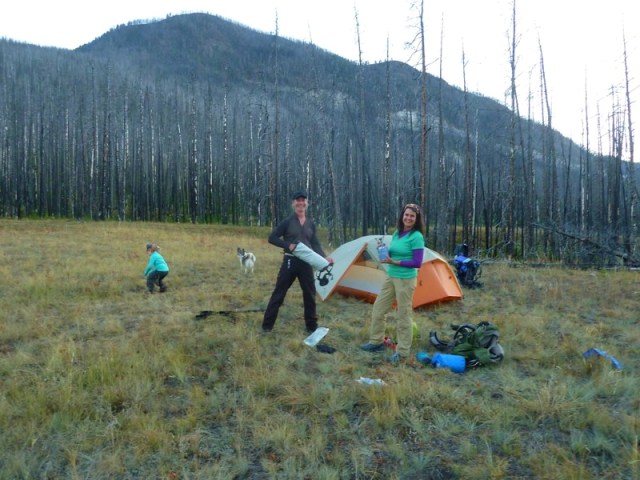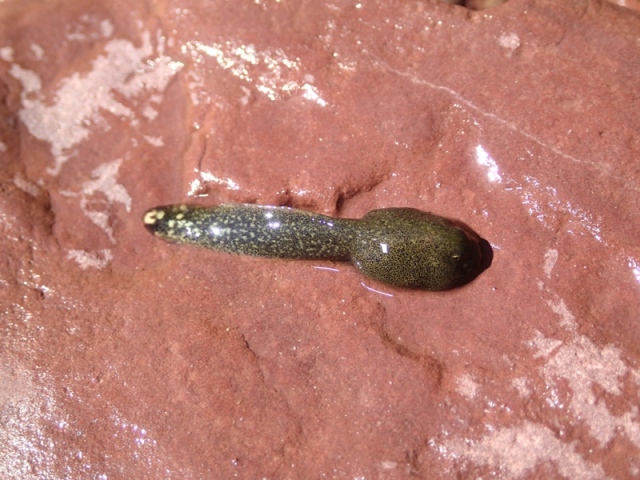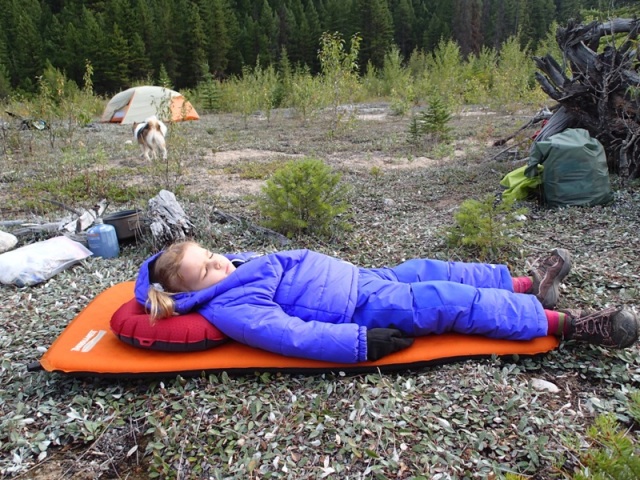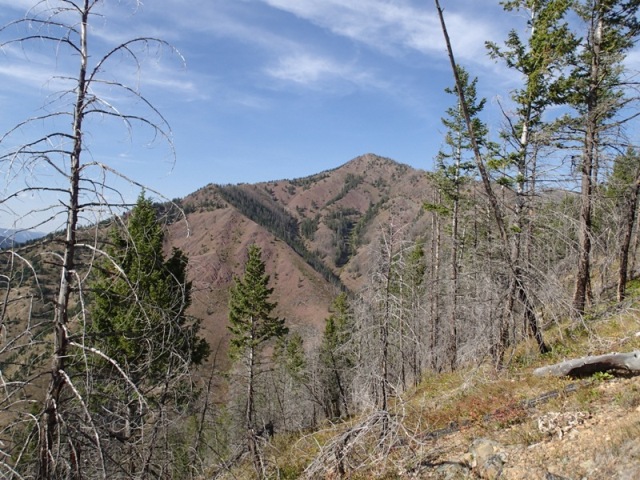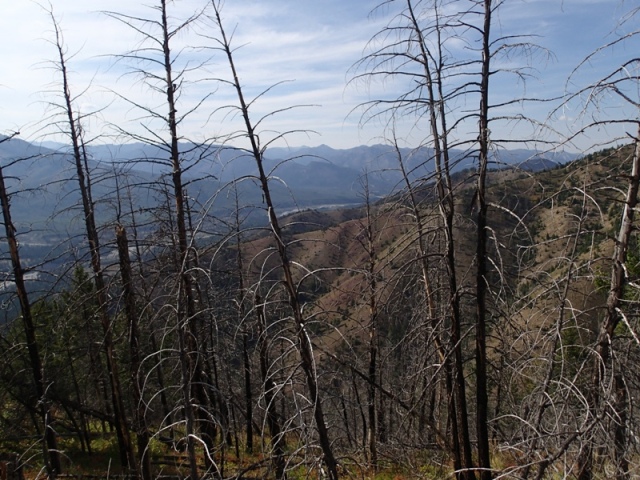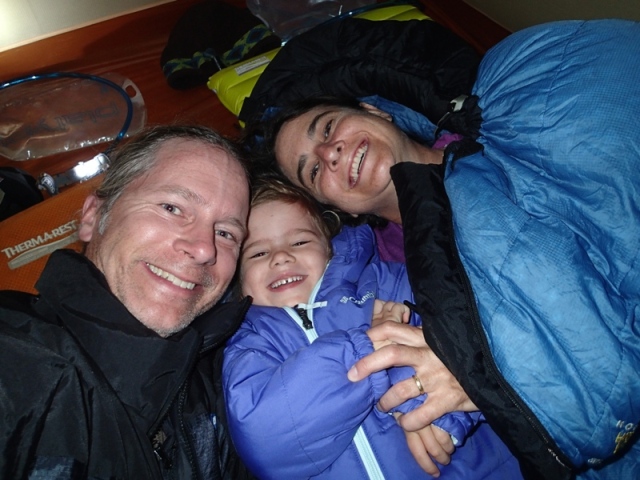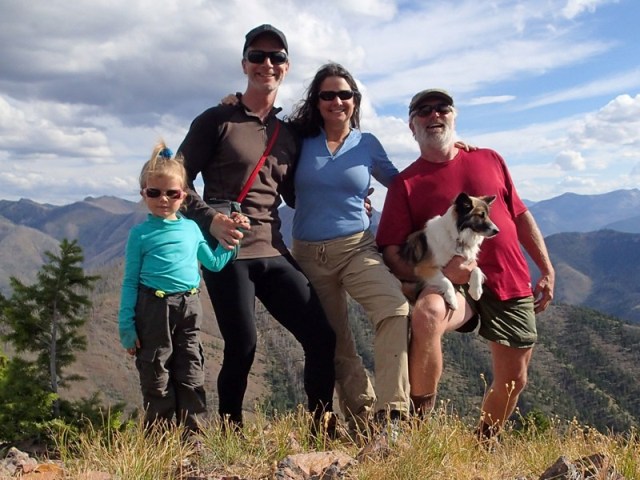Distance to Nearest Road: 18.0 miles
Cell Phone Coverage: No
Public Land: Yes, Bob Marshall Wilderness Area
Travel Method: Hiking (multiday backpacking)
Travel Time One-Way: 5 Days
Something We Learned: Young kids can become as bonded to the outdoors as adults. Spending family time together outdoors is probably key to creating the next generation of conservationists. Any time spent outside is great, but, as we discovered on this trip, “the greater the challenge, the greater the reward.” (Skyla still longingly refers to Montana 4 years later…)
Project Remote is working to precisely calculate and travel to the remotest locations in each of the 50 United States. Below is a written account of our 10-day, 65-mile hiking expedition to document the Montana Remote Spot. This is our 22nd state Remote Spot documented as part of Project Remote.
In Ryan’s words:
September 10, 2013. The plains of eastern Montana roll endlessly westward until you see it. The Rocky Mountain Front Range thrusts skyward into the big blue. We approach the beginning of our 10-day backpacking hike to the Montana Remote Spot. This is the legendary “Big Sky” country, and it provides plenty of eye candy. The rugged mountains and their dark green coniferous forests are encapsulated by the Lewis and Clark National Forest, inside which the Bob Marshall Wilderness Complex exists. The Bob Marshall Wilderness Complex, composed of the Bob Marshall, Scapegoat, and Great Bear Wildernesses cumulatively measure just over 1.5 million acres (see wilderness.net for more info). This is the third largest wilderness complex in the 48 conterminous United States. As everyone who knows this area affectionately calls it, the “Bob,” itself, measures just over 1 milllion acres. The remotest location in all of Montana resides right in the center of the Bob, quite fittingly. We are beyond excited to live and travel for the next 10 days inside of it. That is, we are about to GO REMOTE in Montana. This will prove to be our longest wilderness exposure as a family unit thus far and will be the longest distance yet traveled by foot for Project Remote. We anticipate 65 hiking miles and around 10 days spent in the wild. Also, the Montana Remote Spot, at 18 miles from a road, will be the remotest location we have yet to accomplish thus far in Project Remote. Along with the excitement, we’re also a little anxious. After all-this is grizzly bear country-and, as always on Project Remote, we have our 4-year old little girl with us.
We arrive at Sun Fork Sun Trailhead. Due to recent fires and trail closures this is the chosen beginning point of our hike. From here, we will hike 5 days westward into the center of the “Bob, ” and then we will turn around and come back to our parked car. Despite great efforts to shave off weight and acquire the lightest gear possible, my beginning pack weighs-yikes-70 lbs. That’s the reality of carrying 10 days worth of gear and food for 3 people in the wilderness. Rebecca’s beginning pack weight-the Skyla backpack-weighs 51 pounds. Another wide-eyed yikes. We do train for these trips, though, but how can you compare flatland Florida hiking at sea level to the Rocky Mountains at elevations averaging well over one mile high? We’ll find out. Our long time Alaskan friend, companion, and wilderness mentor, Hank Timm, is joining us on this sure-to-be-epic remote spotting journey. His trusty companion, Vika, an Icelandic Shepherd, also joins us. Hank’s pack weighs in at a hefty 59 lbs. Five of his pounds are gear he is relieving me of. What a nice friend. Later, I will take back this weight when our packs lighten up a bit. Vika also carries her own weight in a dog backpack. It weighs in at an impressive 5 lbs. It is a great pleasure to have the company of Hank on this trip. Hank is an enormously experienced wilderness traveler, recently retired biologist, and father of three. He and his wife, Mary, raised their three children in the Alaskan bush, built their log home in the wilderness, home schooled the youngsters, and maintained biologist jobs with the U.S. Fish and Wildlife Service in Alaska for decades. Their story always has been inspiration for Rebecca and me. Now, we are proudly doing the same thing in a slightly different configuration. We have learned so much about wilderness and conservation from our life-long friends-the Timm Family!
After about a mile and a half down trail, the Remote Spotters enter the iconic Bob Marshall Wilderness.
The surrounding landscape is burned as far as one can see down valleys and up mountainsides. We estimate this is a 6-year old burn in a once mature, dense lodgepole pine forest. Young regenerated pines are sprouting up all over the open understory. Our estimation of burn age comes directly from estimating the age of the young pines. They appear to be about 5-6 years old, a figure identical to the number of branch bundles counted along the stems of the 3-foot tall young pines. Many of the old pines that burned already have blown down in mountain wind storms.
Despite getting a late afternoon start on our first hiking day around 3 p.m., we achieve 4.8 trail miles. We decide to make first camp on a grassy bench overlooking the Sun River. There are a few factors that go into finding a suitable camping spot in the wildereness while backpacking. Number one? Proximity to water. We have the Sun River. Check. Number two? Flat or at least flatish ground. Bench near river. Check. Number three? Timing. It is nice to have a spot picked out before sundown in order to give yourself time to enjoy the late afternoon and get all chores like pitching tent, pumping water, and dinner cooking, done before dark. Of course, timing is a preference thing depending on the mood of the traveler(s). Since we are traveling with a little girl who needs some play time and freedom outside riding in the backpack, timing is important for us. Our spirits soar in first camp. We are elated to have made good distance with such heavy loads on our backs this first day. No injuries. No blisters. Yet.
Speaking of play time, Skyla has rapidly found a fun activity. She makes camp for her girls and builds them a stick hut to take shelter in for the night. She probably gets this idea from watching her parents make camp. She is totally occupied and content. There are so many interesting things all around to occupy a young-or old-person’s mind. It’s great to see her totally at home in the outdoors. We always tell her: “Home is wherever you are.” And wherever we are together.
We awake at camp to a light frosting, ready to hike deeply into the Bob on Day 2. The weather is amazingly clear, cool and arid, a nice break from our usual sweltering, humid Florida heat. We walk westward along the West Fork Sun River all day. Leaving camp around 10 a.m. and hiking with frequent rests until 5 p.m. hits the sweet spot for our traveling needs. Vika has become our friendly and watchful companion. She eagerly assumes her natural bred role as watchdog and shepherd-corralling the Remote Spotters as we head toward those high mountains. We must eventually ascend up over the Continental Divide at White River Pass (elev. 7600 feet)-a climb of about 2200 feet in gained elevation. We plan to reach the base of the mountain spine today and do the ascent tomorrow.
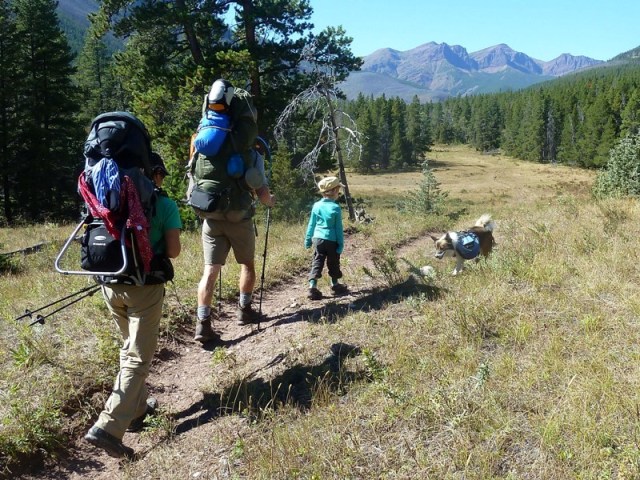 Open grassy meadows abound in the mixed coniferous forest. These dreamy open spaces are probably created by fire regime, microclimate, and soil type over time.
Open grassy meadows abound in the mixed coniferous forest. These dreamy open spaces are probably created by fire regime, microclimate, and soil type over time.
At Camp 2, Hank successfully patches a huge hole in his air mattress created by Miss Vika’s claws…Good thing we brought a patch kit along. When you have gear that could be vulnerable to failure, it’s a good idea to bring along repair essentials on long wilderness forays. I can’t imagine how miserable Hank would have been without a barrier between himself and the cold, hard ground for the next 8 nights.
Meanwhile, on the second night, Skyla learns essentials of campfire building. It’s all about the right combination of dry sticks for fuel and correct placement of fuel to allow the fire to breathe…She is fascinated by the flickering orange flame and the heat it produces. Of course, we teach her of the dangers inherent to falling into the fire or touching red hot coals. She is very receptive to learning and appropriately cautious of getting too close. It is almost as if she has a genetically ingrained behavior around fire. It shouldn’t come as a surprise. Cultivation of fire is one of those uniquely human activities. The importance to our species of the discovery of fire cannot be overstated. It simply feels right to have a camp fire. A fire in the wilderness provides a focal center for groups of interacting humans. It creates a sense of security, especially after dark. Not too long ago, geologically speaking, there were larger than life megafaunal predators lurking across the northern continents (saber tooth cats, dire wolf packs, cave bears, lions, etc.). Critters probably were afraid to come close to human encampments that had large fires. But the most important aspect that fire provides is warmth when it is cold…This discovery probably allowed early humans to move into cold climates and stay warm while doing so. The warmth seems to be what Skyla likes the most. It’s definitely what her warm-blooded, Florida-born daddy likes the most…
On Day 3, we make our 2200 foot ascent of White River Pass and descend back down 1000 feet to make our third camp. Today features many new sights and experiences along with the strain of mountain climbing with heavy loads. But the great weather continues to hold. In order to lessen our weight, we decide to cache some of our food and related gear at the base of the ascent. We will get it on our return from the Montana Remote Spot. We hang it up high in a tree away from scavengers and predators, such as the grizzly bear. Despite, the cache, I still must heft 68 lbs over the pass, while Rebecca and Hank carry 49 and 52 lbs, respectively. Early on in Day 3, we encounter frequent grizzly bear scat piled up in the center of the trail. The contents appear to be barely digested mountain ash berries. It’s fresh. Knowing there is a grizzly bear sharing the trail with us today heightens our awareness. I grow wary. As protection from potential misencounters with bears, we are packing a light, aluminum-framed .357 magnum revolver along with a can of bear pepper spray. Vika also provides a measure of protection because she watches for and barks at most mammals that she detects. We hope for the best kinds of encounters, while preparing for the worst. I figure not to be ill-prepared, since we have the only daughter in the world we will ever have with us…Being in grizzly bear country brings one of the greatest heightened senses of awareness to me. At night, when something stirs outside the tent, you wonder what’s making the noise. Your mind can play tricks on you. Bear anxiety can sent in. You have to rely on your senses, good judgement, and experience. If you do the right things in bear country, such as keep food smells out of camp and make plenty of noise on the trail, you are extremely unlikely to have a negative bear encounter. The bear on our trail with us today appears to well-fed on abundant berries. That’s a plus.
We gain elevation quickly and steeply on Day 3. Excitement builds as we get closer to the summit. Late summer is simply marvelous in this Montana mountain wilderness.
A stream cascades over red sandstone into a shallow pool. We stop for a water break and a rest. A vibrant green tadpole darts around in the pool as we approach for water. Immediately, I think of my graduate advisor, Dick Franz, whom I had a conversation with before setting off on Project Remote North. He told me-“Be sure and look for the tailed frog when you are remoting in Montana. I did my Master’s work on it in graduate school while at the University of Montana.” Admittedly, I had never heard of it up until that conversation.
The tadpole is unlike any other we have experienced far away in the Southeast U.S. Based on what I’d learned from Dick, I believe it to be and later confirm that it is a larval tailed frog (Ascaphus truei). I capture it and snap a photo and observe its body plan. Its mouth is large and circular, apparently built for sucking algae off of submerge rocks and staying in place in heavy current while doing so. The tailed frog is the only frog with a “tail,” which is really a copulatory structure in males that is inserted in the female to deliver sperm internally, also unique in the frog world. Internal fertilization in the tailed frog apparently is an adaptation to living in swift rivers and streams of the Pacific Northwest where sperm would be washed away otherwise. Fascinating. That gets added to our life list of cool critters. I can’t wait to tell Dick about it…
Mountain ash covers a hillside in a natural burned clearing near the summit. Its berries are ripe and plentiful. More bear scat. We ascend and rest again. I turn my head for a view across the deep mountain canyon cut by the upper West Fork Sun River. “Bear!” I instinctively over-voiced so that the girls could hear me. Hank was around the corner out of view. Rebecca and Skyla both turn where I’m pointing. They each spot the quarter-mile distant bear clinging to the opposite canyon slope. The bear looks toward us and scurries intently into thicker brush cover. Of course, it all happened too fast to be able to get a photo, but one was burned into our memories nonetheless. The perfect bear encounter.
Abundant mountain streams offer plenty of water along our route to the Montana Remote Spot. We pump all of our water through a portable, lightweight water filter made for backpacking to ensure that we don’t ingest any microorganisms that could wreak havoc on our G.I. systems…
In long-distance hiking, often times our feet can give us trouble in the form of blister formation or discomfort due to increased and prolonged pounding on your feet for hours beyond their normal capacity. Frequent rests can ameliorate foot issues. I have found that soaking my feet in a cool creek can wash off foot cheese, close the sweat pores, and cool off potential hot spots before blisters have a chance to form. I call it a
“foot soakin.”
We make the final push to the 7600 foot pass, which also happens to be the continental divide.
We take a nice rest and soak in the gigantic views on the Continental Divide. Looking westward, we spot the region of the Bob near where the Montana Remote Spot resides. First view of the remote area we are heading into brings excitement. The geology is fascinating and in-your-face…Sedimentary strata are nearly vertical, all folded and crunched together. Vertical rock walls and cliffs abound.
Beyond the pass, we descend rapidly 1000 feet down trail into the upper White River drainage, along Molly Creek. We are hurting, but with no lasting injuries from our lofty ascent/descent combo. We find a good camping spot and make Camp 3.
Early in Day 4 before we make the full descent from the Continental Divide, we score a line of sight view of Rampart Mountain. The Montana Remote Spot is situated about 500 feet down slope from its summit. Its slopes appear to be largely burned. It should be interesting climbing up there off trail to the Remote Spot. But first, our task for today is to hike several miles down the near valley, then around the mountain side to the left to get to the base of Rampart Mountain.
We descend nearly 2000 feet to the valley bottom and the aptly named White River. The local lithology appears to be white limestone. We negotiate a river crossing to get ourselves on the correct (north) side of the river to make our Remote Spot attempt up Rampart Mountain. Recent dry weather has the river levels relatively low. We go to calf deep and our boots fill with water. Our hot spots cool down. When I cross a river and get my feet wet, I like to stop on the other side, squeeze out as much excess water as possible, then continue walking. Eventually the feet dry. This kind of arid weather greatly aids drying.
Hank hoists Vika onto his back while river crossing. This keeps her safe and her food inside her backpack dry. She is agreeable.
Base camp at the foot of Rampart Mountain
Skyla builds a rock castle in camp…
Rebecca turns 4-0 at Remote Spot basecamp…
Hank makes a huge caribou stew for Rebecca’s birthday dinner! It’s from a recent Timm hunt, dehydrated, and straight from the Timm Family wilderness kitchen in Alaska…
Skyla’s favorite activity? Eating, of course.
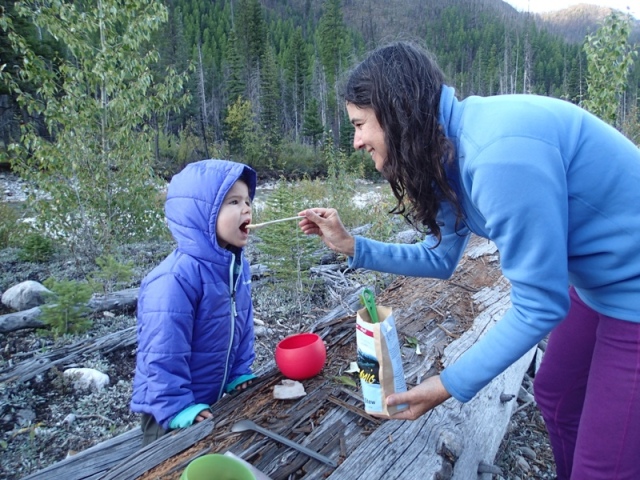 The sun sets beautifully on Rebecca’s birthday in the center of the Bob. The White River transforms into a red river for a few minutes.
The sun sets beautifully on Rebecca’s birthday in the center of the Bob. The White River transforms into a red river for a few minutes.
Skyla gets sick on the morning of our planned Remote Spot attempt. She vomits all in the tent and more outside. It’s a terrible feeling for us parents, not to mention for little Skyla. Firstly, we are 4 days by foot back to the parked car. So if it were something serious, we would be incredibly challenged. We monitor her.
She gets drowsy and asks to nap. Lucky for her and our little mission, she recuperates rapidly after an hour-long nap in the soothing sunshine.
We regroup just after noon and decide to attempt the Remote Spot. Hank returns from a 4-mile reconnaissance walk along the base of Rampart Mountain to figure out the best ridge line to hike up to the Remote Spot. We strike out off trail a short distance from base camp up the mountain. We all lighten our loads by leaving camp intact, only taking what’s needed for a long mountain day hike. I take on the Skyla backpack at 51 lbs, but it still feels lighter than 68 lbs I managed over the pass. Often and early, the slopes get almost too steep for comfort. We push on up the grassy, rocky slopes, zig-zagging back and forth. We must ascend over 2000 feet off trail. We agree to set a time of day whereby we decide to turn back if we haven’t reached the Remote Spot yet so that we can be assured of returning to camp by sundown. We don’t want to get caught off trail on the side of a mountain in the dark.
We reach a sub-summit at around 6800 feet, at our cut-off time of 4 p.m. The Remote Spot still is 0.8 miles away-an eternity of overland travel at this time of day in this steep terrain. The Montana Remote Spot is in plain view across a deep valley, hundreds of feet below our present location. But reality sets in. We cannot make the Remote Spot today. We decide to conduct a Remote Spot Assessment at this location anyway in order to obtain some data. Our feelings are mixed. Happiness, fatigue, and disappointment.
In looking across the deep valley to the summit of Rampart Mountain and the slope that contains the Montana Remote Spot, we obtain a clear view of another ridgeline leading to the Remote Spot that appears to be longer, yet less steep and perhaps easier to hike. The Remote Spotters deliberate over the possibility of making a second attempt to doccument the Montana Remote Spot tomorrow. It is still too early to make the decision. We decide to rest on it and see how we feel tomorrow-all contingent on assessing our mood, remaining food supply, and foot condition.
We head back down the mountain back to camp a little bummed, but we keep the hope of attaining the Remote Spot tomorrow in the back of our minds. The steep descent is painful on the knees and quads. We proceed with caution, but descend the mountain much faster than we ascended it…
We descend rapidly to the bottom. Our first attempt to doccument the Montana Remote Spot from basecamp featured a 2300 foot steep, off-trail hike up a ridgeline flanking Rampart Mountain. We traveled 4 total miles of distance out and back.
We arise the next morning, Day 6, raring and ready to make a second attempt to Go Remote up Rampart Mountain. There is nothing like a good night’s sleep, a good meal, and a little time to lift spirits in preparation for whatever must be done. And more importantly-no one is sick!
We estimate that our second attempt up the far ridgeline we spied yesterday may be twice as long distance-wise as yesterday’s attempt, but it shouldn’t be as steep, and we are getting an early start on the day in contrast to yesterday. It turns out to be plenty steep, but the walking is relatively clean with little brush. Part of the ridge line is burned.
It takes several hours to make it all the way back up to near the summit of Rampart Mountain. The summit comes into view and excitement builds. The going gets rockier and steeper near the summit. We also have a turn back time agreed upon for today, like yesterday. It’s 3 p.m., close to our 3:30 p.m. turn-around time. No Remote Spot yet. I start to get frustrated….We check map and GPS only to confirm that, even if we do reach a suitable place near the summit of the mountain, we will have to drop down the mountainside a full 500 steep feet to reach the Remote Spot. Steep topography of the mountain dictates that we must first go much above the Remote Spot in order to drop down and attain it. Dang it, I don’t think that’s possible for us with the time remaining in the day. I mull this over as we reach a saddle near the top.
We reach the saddle on the southwest flanks of Rampart Mountain. It’s 3:30 p.m. Turnaround time. No Remote Spot yet. We are just 0.18 miles straight line distance from the spot, but that will mean a steep drop of 500 feet, then back up because of the treacherous lay of the land. The solution? I volunteer to drop the Skyla backpack and descend solo down the lonely steep mountainside in order to obtain photo/video documentation from the exact Remote Spot. Without extra weight on my back, I’m confident that I can mountain goat it down and back up the slope within a short enough time such that we can make it back down the mountain before sunset…Everyone agrees. (Squint your eyes to see Ryan descending the mountain in the middle of the photo below)
Meanwhile, Rebecca conducts the 15 minute Remote Spot Assessment from up top the saddle while I am down below getting photo/video. Hank and Vika are looking after Skyla. Everyone contributes vitally to our success in documenting the elusive Montana Remote Spot…
The Montana Remote Spot-looking south.
It takes me 20 minutes to get down to the Remote Spot, 20 minutes to photograph, and about 20 to scurry back up. We are nearly an hour past our turn-around time, but absolutely high on our decision to make a second attempt at the Montana Remote Spot after yesterdays failed attempt. It feels like we accomplished a Denali or an Everest summit. To us-even better. As far as we know, no humans have ever stood in this exact location simultaneously with the knowledge that they were occupying the remotest location of one of the least populated, wildest states left in America. We are 18 miles from a road, 31 total hiking miles, and 5 foot-based travel days from what we preliminarily believe to be the second remotest state Remote Spot that exists on the mainland of the continental United States. Other than con trails, which are an eye sore and conservation conundrum in the atmosphere, we measure zero human presence terrestrially from the Montana Remote Spot.
The Remotest Family in Montana
Before we leave, we take in the colossal view from near the top of the mountain. A wildfire flares up in the afternoon heat (mid 70’s) and low humidity. Since we entered this world-class wilderness, we have observed that the natural fire regime is ecologically intact here. There is a mosaic of different-aged burn patches mixed within an ocean of green . We actually are surprised at the sheer amount of the landscape that is in burn. Seems about like a ratio of 50 % burn, 50% not burned. Intact fire regimes are characteristic of large, untrammeled places where the footprint of people is minute and there are ecologically favorable land management policies . First and foremost, these are the places that we must preserve forever if we, as a nation, are going to save something natural, wild, and free for future generations-and for the conservation of biodiversity. We are pleased to be in one of these places.
Our return hike route back down the 2.5 mile long ridge to the White River is fully in view from the top…Base camp is another 2 miles upstream (to left) when we return to the trail along the river. Our days hike from basecamp to the Montana Remote Spot and back turned out to be nearly nine miles, 5 of which were off-trail up and down Rampart Mountain.
We arrive back at camp just before dark, do some chores, such as retrieve our hanging food in a tree…
Then the celebration begins! Dinner, then straight to bed. Our feet and bodies are aching but our high spirits numb the pain. We are proud that we dug down deep inside to find plenty of gumption to attempt the Remote Spot a second time-and succeed.
The remaining four days of our return trip feature more fabulous weather and the close sighting of another grizzly bear. The second encounter is more exciting than the first. Rebecca looks up from the trail and spots the bear only about 50 yards off the trail from where we stand. Vika barks, and the bear sprints out of view. It’s large, muscular body ripples each time its feet hit the ground. It’s speed amazes us. We are very happy it didn’t charge in our direction. It all happened too fast to get a photo…Another fine grizzly encounter.
Men in tights-in the Bob.
Back up and over the continental divide a short distance, we take a short side hike northward to hopefully gain a view of the Chinese Wall, a very prominent 20-mile long escarpment of exposed rock face nearly 1000 feet tall that spans north-south through the Bob. We don’t achieve a comprehensive view of the wall, but get views of its southernmost exposure from near White River Pass. But, better than the Chinese Wall, we spot mountain goats on a steep rock face. Another first for our critter life list.
Summer turns to fall along the Chinese Wall…
Good feelings on the downhill past White River Pass!
Our first rainy day after 8 days of sunshine. We certainly don’t complain…
While on our hike we encounter several pack horse caravans carrying travelers or hunters. Hikers and horse travelers use the same trail system within the Bob. We certainly think that horse travel is an acceptable, non-motorized travel method, but the unfortunate thing is that hikers must navigate through and around abundant manure and mud holes on the trail and at campsites. Mud holes are perfectly fine. It’s wilderness, after all. But hyper-abundant manure is an issue. Horse manure covered almost every campsite we visited (it wasn’t just concentrated in one location)…a person’s remote psyche takes a hit when eating and sleeping surrounded by horse manure.
Not only are such large concentrations of manure unsightly and foul-smelling, we also hypothesize that there may be a certain amount of nutrient pollution finding its way into streams and rivers, especially during heavy use seasons. It is a dilemma that may need some management attention in areas with abundant horse traffic. One solution may be to hire trail workers or have volunteers hike in and shovel manure off the trail as well as removing excess manure out of stream basins and campsites. Or maybe the horse travelers themselves should be tasked with managing their own horse’s manure. Maybe have the horse wear a dump sack. If human travelers are asked to poop 200 feet from water sources, perhaps horses should be as well. Anyway, the issue seems solvable. Hikers and horses both belong in wilderness…
Skyla continues her fire building instruction on the 8th camp of our trip.
Skyla also has taken to journal writing. We provide her writing lessons at home or in the wilderness. Her schooling goes on all day. Every day. Inside or outside. Living and learning are synonymous and simultaneous.
On Day 9, I encounter a western U.S. species of garter snake draped across the trail. How exciting! I instinctively pounce on the snake and lift it up to provide Skyla with a view…
Early fall along the West Fork, Sun River in the Bob.
On our last night (Camp #9), we find a beautiful grassy meadow by the West Fork Sun River. Intermittent rain showers are enough to make us set up our 8′ x 10′ tarp used for cooking under and getting out of the rain.
Our final camp in the Bob, after 10 days, 9 nights, 65 hiking miles, four summits averaging 2300 feet elevation gain apiece, and much tenacity…
As a family, we are greatly strengthened by our longest continuous outdoor exposure together. But the singular greatest moment for Rebecca and me happens on our final morning of Day 10. Skyla, realizing that we are leaving the Bob today, looks up at us with teary eyes. In a broken, sad voice, she says she doesn’t want to leave this place-that she doesn’t want to leave the wilderness. I become filled with emotion, myself, as I realize that our child loves being outdoors at age 4 so much that it gives her tears to leave. Any time I see her cry, of course, it saddens me as a father. But this time, I am both sad and happy for her. Raising her in the outdoors-having her imprint first on the natural, real world versus the virtual, indoor one -is our greatest desire as parents. It isn’t being in the Bob, itself, that provides us with the greatest satisfaction. It’s the verification that our outdoor lifestyle is having a profound positive impact on Skyla. As I journey through the Bob and through the greater wilderness of parenthood…I think to myself, “Mission accomplished.”
After reading this website, you might be surprised at just how hard it is to get away from a road or a town nowadays-and instantly understand that we must now as a nation speak out to protect remaining public roadless areas from further roads development. Project Remote is now over half-way done! Our goal is to raise enough funding simply to offset the cost of traveling frugally state by state, completing the documentary field work, and maintaining this website. This work depends on donations from people like you. If you like what we do, please Click here to make a donation to support Project Remote today. Thank you so very much for helping us to document and preserve Remote America… -Remote Spotters
